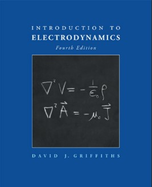Solution Found!
A thick spherical shell (inner radius a, outer radius b)
Chapter 4, Problem 15P(choose chapter or problem)
Problem 15P
A thick spherical shell (inner radius a, outer radius b) is made of dielectric material with a “frozen-in” polarization
where k is a constant and r is the distance from the center (Fig. 4.18). (There is no free charge in the problem.) Find the electric field in all three regions by two different methods:
6The polarization drops abruptly to zero outside the material, so its derivative is a delta function (see Prob. 1.46). The surface bound charge is precisely this term—in this sense it is actually included in ρb, but we ordinarily prefer to handle it separately as σb.
(a) Locate all the bound charge, and use Gauss’s law (Eq. 2.13) to calculate the field it produces.
(b) Use Eq. 4.23 to find D, and then get E from Eq. 4.21. [Notice that the second method is much faster, and it avoids any explicit reference to the bound charges.]
Reference equation 4.23
Reference equation 4.21
Reference equation 2.13
Reference Prob. 1.46
(a) Show that
[Hint: Use integration by parts.]
(b) Let θ(x) be the step function:
Show that dθ/dx = δ(x).
Questions & Answers
QUESTION:
Problem 15P
A thick spherical shell (inner radius a, outer radius b) is made of dielectric material with a “frozen-in” polarization
where k is a constant and r is the distance from the center (Fig. 4.18). (There is no free charge in the problem.) Find the electric field in all three regions by two different methods:
6The polarization drops abruptly to zero outside the material, so its derivative is a delta function (see Prob. 1.46). The surface bound charge is precisely this term—in this sense it is actually included in ρb, but we ordinarily prefer to handle it separately as σb.
(a) Locate all the bound charge, and use Gauss’s law (Eq. 2.13) to calculate the field it produces.
(b) Use Eq. 4.23 to find D, and then get E from Eq. 4.21. [Notice that the second method is much faster, and it avoids any explicit reference to the bound charges.]
Reference equation 4.23
Reference equation 4.21
Reference equation 2.13
Reference Prob. 1.46
(a) Show that
[Hint: Use integration by parts.]
(b) Let θ(x) be the step function:
Show that dθ/dx = δ(x).
ANSWER:
Step 1 of 3
We are required to calculate the field produced by the bound charges.
